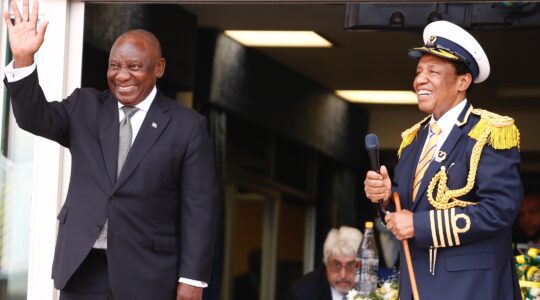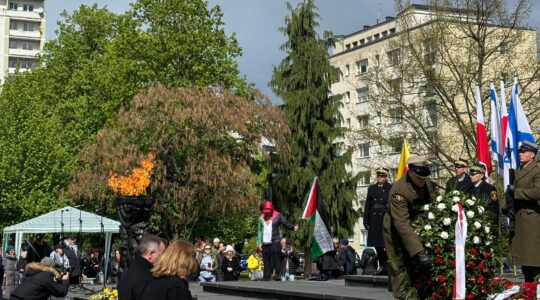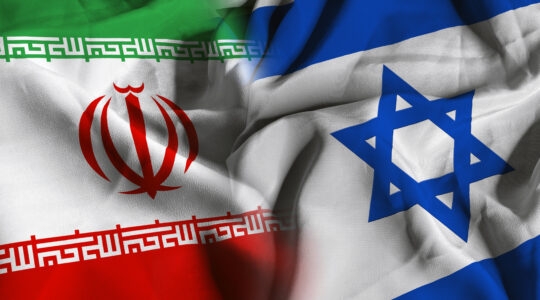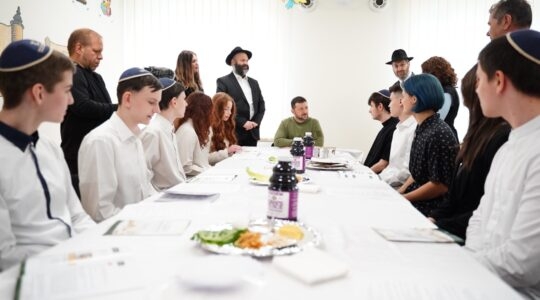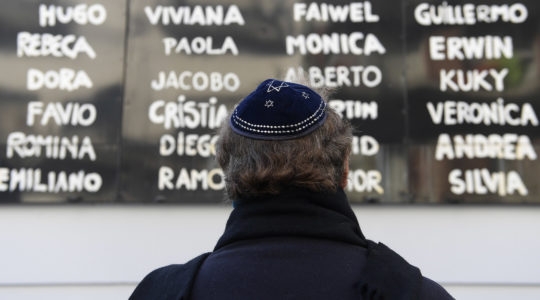
Robert Augustyniak, right, guiding a tour in Grodzisk with Zofia Szulman, a native of the Polish town now living in the United States. (Anka Grzegorzewska)
WARSAW, Poland (JTA) — Marek Tuszewicki is doing doctoral work at the Institute of Jewish Studies at Jagiellonian University in Krakow, teaches Yiddish at the Krakow JCC, and leads a club that brings together those who like to sing Chasidic songs and read Yiddish literature.
He also co-founded a Jewish literature and art quarterly called Cwiszn and publishes articles and poems in Yiddish.
There’s just one thing: Tuszewicki is not himself Jewish.
“There is the whole Polish background with the ruins of cemeteries and synagogues from which there is no escape,” Tuszewicki told JTA.
“There are more and more people interested in Yiddish and opportunities to learn,” he said. “What are the proportions of Jews and non-Jews I cannot say exactly, but I’m sure at the university there are more students from non-Jewish backgrounds.”
Tuszewicki is among the growing number of non-Jewish Poles who are immersing themselves in Jewish culture. They organize Jewish events or ceremonies commemorating the Jews who lived in their cities. They are building monuments and teaching others about the history of their Jewish neighbors. They write in Yiddish.
Many Poles have begin to look at Polish Jewish history as part of their own cultural heritage — something to be appreciated and remembered, not cast aside.
“I know that many Poles are interested in Yiddish because it is the heritage of Poland,” Tuszewicki said. “Yiddish developed here and great Yiddish literature has been written here. Besides, it not only coexisted with Polish, but it also entered with it into intensive contact. Forgetting Yiddish we would forget an important part of our culture.”
Martyna Majewska is another of the many Polish gentiles to have charted a Jewish path. She was granted a scholarship from the Jewish Foundation for the Righteous to teach about the Holocaust and Jewish history. She took part in education courses organized by Israel’s Yad Vashem Holocaust memorial and museum.
Majewska also co-authored a book called “Warsaw: City of many cultures” that helps educators teach about Poland’s minority communities.
Now Majewska, along with Marcin Kozlinski, a fellow Polish gentile, is preparing the first postwar Polish animated fairy tale in Yiddish. It’s part of the Multicultural Mosaic of Tales and Legends project funded by the U.S. Embassy in Warsaw. The Jewish story is titled “Happy Man” and will be a short animated film in three languages: Polish, English and Yiddish.
“We decided to create a series of stories so children could learn more about the fairy tales in different cultures and see that they have universal appeal,” Majewska said. “And another advantage of every fairy tale is that it can be seen in its original language, giving the opportunity to familiarize children with an unknown language.”
Bogdan Bialek does not speak Yiddish. He grew up in a Jewish neighborhood in Bialystok, where he had Jewish friends. One was a neighbor who was a survivor of Auschwitz from whom he learned about the Holocaust.
Poland’s anti-Zionist campaign of 1968 decimated what Jewish life remained in Bialystok, and Bialek eventually moved away, marrying a girl from Kielce, the site of a 1946 pogrom resulting from a blood libel.
In Kielce, Bialek wanted to learn more about the massacre, in which 37 Jews and three non-Jewish Poles were killed. The locals, however, were reluctant to talk about it.
“In 1982, one of the priests warned me to not talk about this because Jews kidnapped children and made them into matzah,” he said. “I met with a Poland which I did not know before. Thus began my stubbornness confronting the city with the pogrom.”
Even in the 1990s, with Poland emerging from its communist shell, it wasn’t easy to talk openly about Jewish history. Bialek endured several attacks for delving into Jewish history. Perpetrators threw grenades into the newspaper office where he worked.
But in 1996, on the 50th anniversary of the pogrom, Bialek organized a ceremony commemorating the murdered Jews. Then he began to organize annual memorial marches, the first of which drew just three people. At this year’s there were 300.
He built a monument of a menorah in town as well as a statue of Jan Karski, a hero of the Polish resistance who delivered news of the extermination of Polish Jewry to the outside world. Today, Bialek says, Kielce is a different city than it was a generation ago.
“For many years in Kielce there have been no anti-Semitic slogans on the walls,” Bialek said. “Yes, there are anti-Semites, but they understand that divulging this is indecent.”
A few weeks ago, thanks to Bialek, a sukkah was erected in the mall in the center of Kielce. Locals came to listen to stories and watch films about Kielce’s Jewish past.
In the central Polish town of Grodzisk Mazowiecki, a group of locals convened in 2009 to try to figure out how to commemorate their town’s local Jewish heritage. They started their project, called Jewish Street, by lighting up the walls of the old Jewish cemetery one night.
“I wanted to let people know that the current area of the cemetery is only one-tenth of its original area,” said Robert Augustyniak, one of the project’s initiators. “Since 1953 on the rest of the area of the cemetery there is a junkyard. Most people today do not know that there was also a cemetery.”
In 2010, Augustyniak managed to excavate Jewish gravestones that had been used to build a sidewalk in one of the backyards in town and return them to the cemetery. It was an eerie undertaking, he recalls.
“It was raining that day. From the mud began to appear some symbols: hands, candles, ornaments, plants and finally the Hebrew inscriptions,” Augustyniak said. “Jan Jagielski of the Jewish Historical Institute was with us then. He read inscriptions from the gravestones and we felt that behind these strange-sounding names there are people who ask to be remembered.”
That same year the group organized Grodzisk’s first Jewish cultural festival with workshops, a book fair, meetings, and theater and concert performances. The town’s mayor was an enthusiastic supporter, according to Augustyniak. In 2011, the Israeli Embassy in Warsaw gave Jewish Street an award.
“The memory of the Jews is now fashionable in the city,” Augustyniak said.
Sixty miles away, in Minsk Mazowiecki, Justyna Jekalska decided recently to restore the old Jewish cemetery in her city. Thanks to her efforts, the place was cleaned up and soon will have a new fence.
Jekalska says she was motivated by simple human decency.
“I was ashamed that the cemetery in my city looks like that,” she told JTA.
“I’m not associated with Judaism in any way. I phoned rabbi’s office. It turned out that they liked the idea that I wanted to do that. It is, after all, not only to clean but also to preserve human knowledge about this place and change the way it is seen.”
